Lisa Lee and Pam Morbitzer
Illinois State University Child Care Center
Normal, Illinois
2015
The How Do People Celebrate Birthdays Project took place in a multiage classroom at the Illinois State University Child Care Center in Normal, IL. The center offers full- and part-time care for children ages 3 to 5. The ISU Child Care Center has three team teachers and several paid teacher aides as well as practicum students. Barb Gallick, Lisa Lee, and Pam Morbitzer were the three teachers involved in project. The project began in January 2015 and ended in May 2015, with 20 children enrolled in the classroom that semester.
Phase 1: Beginning the Project
Over our winter break, we had some children celebrate birthdays. We also had a few children getting ready to celebrate their birthday within the next few weeks. Because of the children’s interest, we thought exploring birthdays might be a viable project topic. We began talking about birthday celebrations at morning meeting. Some topics we brainstormed about included: Where do you celebrate birthdays? What kind of supplies are needed for a birthday? What happens at a party? What kinds of cakes did the children have at their last birthday party?
One day at morning meeting, Levi said, “If you’re older, then you’re also taller.” The teachers and children discussed his idea at length, but then one teacher suggested we needed a more concrete example. During that meeting, the teachers lined up from tallest to shortest and explained that even though Barb was the oldest, she was only taller than one other teacher. To some of the children, it became clear that age and height were not directly connected. Other children still seemed confused, so we decided to develop a chart. The teachers helped measure all the children’s heights and then the children placed their photo on the height line created on the chart. The children could easily see who was taller or shorter than they were on the chart.
However, the comparison between height and age was still not apparent for many children. We created a chart that mapped age and height side by side. This seemed to create a clearer picture of the concept that height and age are not always correlated. The children would say, “Look I’m older than [child’s name], but their picture is above mine on the height side of the chart.”
The children began dictating stories about their birthdays. They illustrated their stories, and we created a book titled Birthday Stories that was available for families to check out and share at home. As a group, the children composed a letter to the parents asking them to write down their family birthday traditions. The teachers typed the letter, and some of the children drew illustrations at the top. The children signed the letter and passed it out to parents, grandparents, and children to gather information about family birthday traditions. Once the teachers felt the children had shared their experiences and past knowledge of birthday celebrations, we created an idea web. When we looked at the idea web as a teaching team, we realized that the children had a solid foundation of knowledge regarding the topic, so we moved forward to Phase 2.


Phase 2: Developing the Project
As we entered into the next phase of our project, families started returning information about their birthday traditions. The children illustrated their family birthday traditions and posted them on the classroom bulletin board to share with our families and friends. Since the children expressed interest in cakes, the teachers displayed pictures of decorated cakes. This inspired the children to bring in pictures of their former birthday cakes as well.
The teachers decided to invite a cake decorator into the classroom to share her expertise. The children formulated questions to ask the decorator during her visit. Heather, the cake decorator, came to visit and showed the children the tools she uses for her work. The children had the opportunity to ask their questions, which included:
- How do you make and decorate cakes?
- Where do you get cake-decorating supplies?
- Do you eat the cakes you decorate?
The cake decorator brought in a photo album of cakes she had decorated. The children enjoyed looking through her photos. Heather brought in some prebaked cakes to show the children how to decorate. She demonstrated how to pipe frosting and make roses out of fondant. The children were given the opportunity to test their cake decorating skills.
After Heather’s visit, the children dictated a thank you note. They continued to have questions about cake decorating and bakeries. At morning meeting, the teachers and children decided to write a letter to parents asking them to take the children to a bakery in town outside of class time. The letter said, “Dear Moms and Dads, Would you help us do homework? If we can go to Walmart or Kroger or a place with a bakery, can you help us write down what we see at the bakery? Like cakes and stuff. Love, the ISU Child Care Kids.” The children signed the letter and the teachers distributed copies to the families. The children returned their homework and shared what they saw with the class at morning meeting.
One of our children shared that his mom’s birthday was on Easter this year. This led to a discussion about the birth dates of our family members. We gathered birthdays of each child’s family and graphed them on our classroom bulletin board. The children drew a picture of each family member on a small piece of paper and then stapled the picture under the appropriate birthday month. We counted the number of people born in each month and discovered May had the most birthdays.
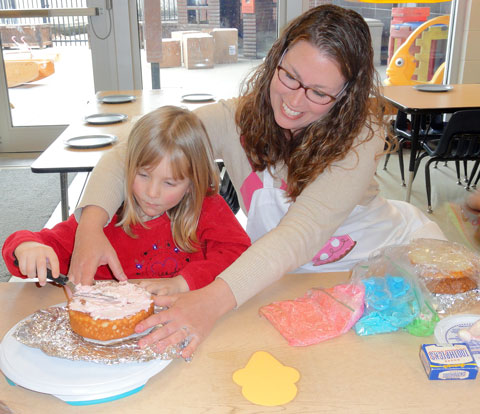
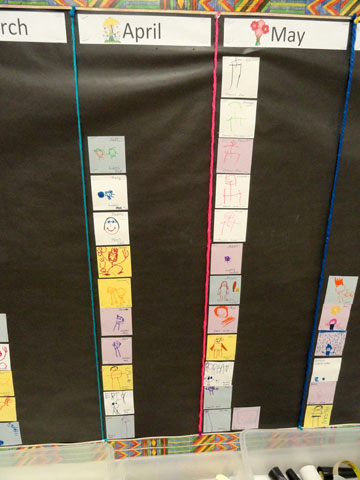
Phase 3: Concluding the Project
At morning meeting, the teachers proposed the idea of having an Unbirthday Party to culminate our project. We suggested to the children that we include the various birthday traditions we learned about during Phase 1 and Phase 2. We asked a family from India to share their tradition of having a head blessing ceremony. Following the Buddhist tradition practiced by one of our families, we decided to collect canned food items for those in need. At ISU Child Care Center, we have a tradition of giving each child a book on their birthday, so we decided to include that tradition in our planning as well.
We made a list of party preparations and decided to divide the children into committees. The committees were: set up/clean up, invitations, food, games, and decorations. After we created our committees, the teachers suggested they decide on a party theme before making further plans. At morning meeting, we created a list of party theme ideas. The children came up with 10 party theme ideas, one being Redbirds, Illinois State University’s mascot. After the votes were cast, it was evident Redbirds was the perfect theme for our Unbirthday Party.
The children selected the committee they would like to be on, and each committee met individually. The committees made lists of tasks to complete. The Invitation Committee drew Redbirds for the invitation and decided what important information needed to be included, such as date and time. The Decorations Committee suggested having a red and yellow color theme for their decorations, which included balloons, streamers, flowers, signs, and table settings.
The Food Committee met and decided that we had to have cake at our party. The children wanted to serve water and lemonade with the cake. The children on the Food Committee baked and decorated a cake for the party. They also arranged for Heather, our expert visitor, to make a large sheet cake as well so there was plenty of food for our guests.
The Games Committee came up with the following activities: a Reggie Redbird piñata, Pin the Beak on Reggie, a head blessing ceremony, eat cake, and have someone dress up as Reggie Redbird. One of our children sketched Reggie Redbird on a large piece of paper, and others painted Reggie to create the “Pin the Beak on Reggie” game and created a piñata out of papier-mâché and tissue paper.
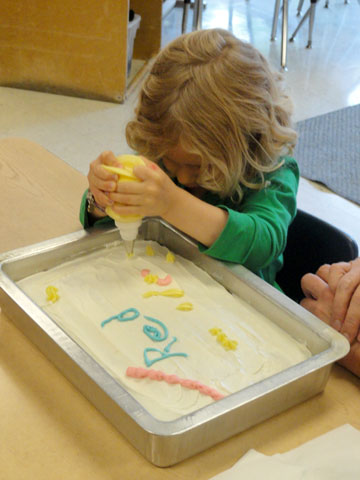

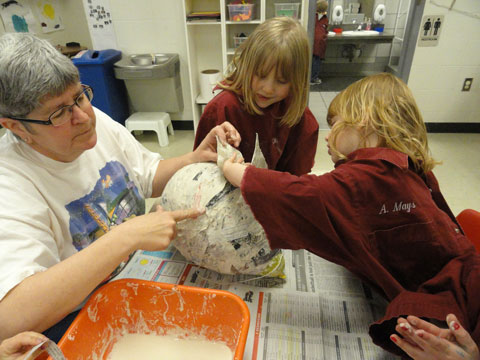
When the party date finally arrived, the Set Up/Clean Up Committee worked diligently to prepare the room for our guests. The children worked hard on decorating a box to collect items for the food pantry. As guests arrived, they placed canned food items in the box the children had decorated. This is an adaption of the Buddhist tradition of making an offering of money and food items to the monks on the morning of your birthday. In return, the monks give you a blessing and donate the money and food to those in need.
Once all families were present, we gathered for the Head Blessing Ceremony. In India, the parents place rice on their children’s head and make a blessing, such as “live long, live one hundred years.” Each parent, family member, or friend took a few grains of rice and placed it on the child’s head as they made their blessing.
We had a variety of stations set up throughout the room to entertain our party guests: “Pin the Beak on Reggie,” red and yellow hand-print painting, Reggie Redbird coloring, and cake eating. We also had a place where each family could choose a book for their child, which is part of our birthday book tradition at ISU Child Care Center. We brought the party outside to do the piñata. It didn’t take the children long to break up the piñata and enjoy the toys and treats inside.
As a surprise to the children, the teachers arranged for ISU’s mascot, Reggie Redbird, to visit the party. The children went crazy with excitement when he arrived. He gave them high fives, rode a tricycle, and went down the slide. He even made giant bird footprints in our sandbox. At the end of Reggie’s visit we took a group picture with him, which was a good way to end our party.

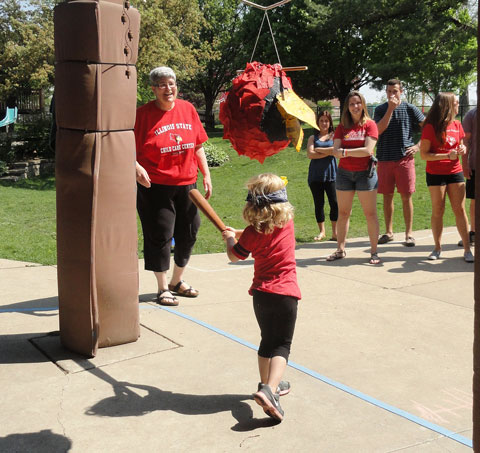

Teacher Reflection
As we approached the spring 2015 semester, we knew we had a group of children who were unfamiliar with project work. Having several winter birthdays led to rich discussions on the topic. Therefore we explored birthdays and were pleasantly surprised by how interested the children were in learning about how different families and cultures celebrated birthdays. We had such a wide variety of family traditions and customs that were represented in our classroom. As the project progressed, we felt that new explorations continued to unfold. The teaching team steered the project more than we have in the past, but the children were very receptive to taking our suggestions and became extremely invested in their work.
When we see the children initiate project themes into their artwork or imaginative play, as teachers we know we have had a successful project. The children showed continued interest in the project after the culminating event. They continued to host birthday parties in dramatic play for the baby dolls. We had children painting birthday cakes at the art easel. The children revisited our Birthday Stories book and birthday cake pictures numerous times. This semester, the children recalled the birth dates of their loved ones and display genuine excitement for them. Therefore, the teaching team was pleased with the outcome of our project.
In addition, we had wonderful feedback from parents on the success of the project. Not only were the families excited to be key players in our investigation of birthdays, they noted many ways their child benefited from our project. Some parents mentioned that their child’s vocabulary blossomed as well as their executive functioning skills, such as being able to formulate and implement a plan.
Other parents were excited their children learned more about traditions from other cultures. Parents described that the children grew in their capacity to be altruistic by seeing themselves as part of a larger community. As a teaching team, we enjoyed the level of parental involvement throughout the birthday project.

